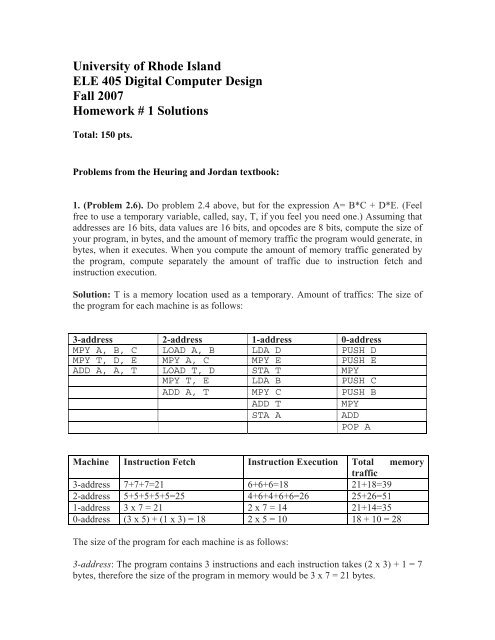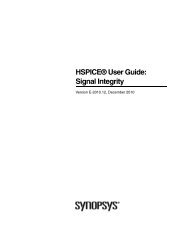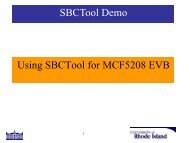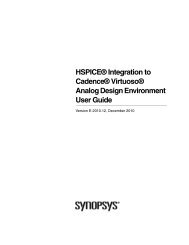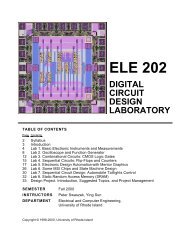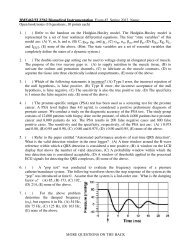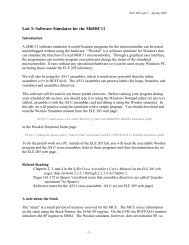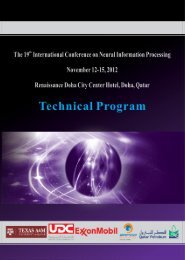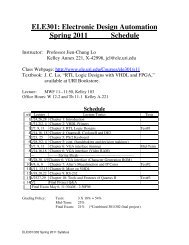Homework # 1 Solutions - University of Rhode Island
Homework # 1 Solutions - University of Rhode Island
Homework # 1 Solutions - University of Rhode Island
Create successful ePaper yourself
Turn your PDF publications into a flip-book with our unique Google optimized e-Paper software.
<strong>University</strong> <strong>of</strong> <strong>Rhode</strong> <strong>Island</strong><br />
ELE 405 Digital Computer Design<br />
Fall 2007<br />
<strong>Homework</strong> # 1 <strong>Solutions</strong><br />
Total: 150 pts.<br />
Problems from the Heuring and Jordan textbook:<br />
1. (Problem 2.6). Do problem 2.4 above, but for the expression A= B*C + D*E. (Feel<br />
free to use a temporary variable, called, say, T, if you feel you need one.) Assuming that<br />
addresses are 16 bits, data values are 16 bits, and opcodes are 8 bits, compute the size <strong>of</strong><br />
your program, in bytes, and the amount <strong>of</strong> memory traffic the program would generate, in<br />
bytes, when it executes. When you compute the amount <strong>of</strong> memory traffic generated by<br />
the program, compute separately the amount <strong>of</strong> traffic due to instruction fetch and<br />
instruction execution.<br />
Solution: T is a memory location used as a temporary. Amount <strong>of</strong> traffics: The size <strong>of</strong><br />
the program for each machine is as follows:<br />
3-address 2-address 1-address 0-address<br />
MPY A, B, C LOAD A, B LDA D PUSH D<br />
MPY T, D, E MPY A, C MPY E PUSH E<br />
ADD A, A, T LOAD T, D STA T MPY<br />
MPY T, E LDA B PUSH C<br />
ADD A, T MPY C PUSH B<br />
ADD T<br />
STA A<br />
MPY<br />
ADD<br />
POP A<br />
Machine Instruction Fetch Instruction Execution Total memory<br />
traffic<br />
3-address 7+7+7=21 6+6+6=18 21+18=39<br />
2-address 5+5+5+5+5=25 4+6+4+6+6=26 25+26=51<br />
1-address 3 x 7 = 21 2 x 7 = 14 21+14=35<br />
0-address (3 x 5) + (1 x 3) = 18 2 x 5 = 10 18 + 10 = 28<br />
The size <strong>of</strong> the program for each machine is as follows:<br />
3-address: The program contains 3 instructions and each instruction takes (2 x 3) + 1 = 7<br />
bytes, therefore the size <strong>of</strong> the program in memory would be 3 x 7 = 21 bytes.
2-address: The program contains 5 instructions and each instruction takes (2 x 2) + 1 = 5<br />
bytes, therefore the size <strong>of</strong> the program in memory would be 5 x 5 = 25 bytes.<br />
1-address: The program contains 7 instructions and each instruction takes (2 x 1) + 1 = 3<br />
bytes, therefore the size <strong>of</strong> the program in memory would be 7 x 3 = 21 bytes.<br />
0-address: The program contains 8 instructions, 5 <strong>of</strong> the instructions take (2 x 1) + 1 = 3<br />
bytes and 3 <strong>of</strong> them take only 1 byte, therefore the size <strong>of</strong> the program in memory would<br />
be (5 x 3) + (3 x 1) = 18 bytes.<br />
2. (Problem 2.9) Repeat Exercise 2.6 for a general register machine. Assume 8-bit<br />
opcodes, 5-bit register numbers, 16 bits data words and 24-bit addresses.<br />
Solution:<br />
Assume that operands and results are stored in memory addresses that can be accessed<br />
with direct addressing.<br />
load R0, B<br />
load R1, C<br />
mul R0, R0, R1<br />
load R1, D<br />
load R2, E<br />
mul R1, R1, R2<br />
add R0, R0, R1<br />
store R0, A<br />
The amount <strong>of</strong> traffics for this general register machine is as the follows:<br />
Instructions Instruction Fetch Instruction Total memory<br />
Execution traffic<br />
load R0, B 8+5+24=27b=4B 16bits=2B 27+16=43b=6B<br />
load R1, C 8+5+24=27b=4B 16bits=2B 27+16=43b=6B<br />
mul R0, R0, R1 8+5+5+5=23b=3B 0 23b=3B<br />
load R1, D 8+5+24=27b=4B 16bits=2B 27+16=43b=6B<br />
load R2, E 8+5+24=27b=4B 16bits=2B 27+16=43b=6B<br />
mul R1, R1, R2 8+5+5+5=23b=3B 0 23b=3B<br />
add R0, R0, R1 8+5+5+5=23b=3B 0 23b=3B<br />
store R0, A 8+5+24=27b=4B 16bits=2B 27+16=43b=6B<br />
Total 204b or 29B 80b =10B 284b or 39B<br />
Size <strong>of</strong> the program:
The program contains 8 instructions, 5 <strong>of</strong> the instructions take 8+5+24=27bits and 3 <strong>of</strong><br />
them take 8+5+5+5=23bits, therefore the size <strong>of</strong> the program in memory would be (27 x<br />
5) + (23 x 3) = 204 bits or 29 bytes.<br />
3. (Problem 2.10) Suppose the instruction word in a general register machine has space<br />
for an opcode and either three register numbers or one register number and an address.<br />
What different instruction formats might be used for an ADD instruction, and how would<br />
they work?<br />
Solution:<br />
Format 1: ADD Rdst, Rsrc1, Rsrc2<br />
Fetch the contents <strong>of</strong> register Rsrc1 and Rsrc2, add them, and then store the result<br />
into register Rdst.<br />
Format 2: ADD Reg, Mem-addr<br />
Fetch the contents from register Reg and memory address Mem-addr, add them, and<br />
then store the result to register Reg.<br />
4. (Problem 2.14) Suppose that SRC instruction formats are considered different only<br />
when field boundaries in the instruction word change and not when some fields or parts<br />
<strong>of</strong> fields are unused. How many different formats should appear in Figure 2.10 in this<br />
case?<br />
Solution: Formats 3, 4, 5, 6, and 7 in Figure 2.9 could be considered as one format.<br />
Format 1 uses a 17-bit constant, so it is another format. Format 2 is also distinct because<br />
it uses a 22-bit constant. Format 8 can be combined with any format that has operand<br />
field, giving 3 different formats.<br />
5. (Problem 2.17) Testing a difference against zero is not the same as comparing two<br />
numbers in finite precision arithmetic. Propose an encoding for an SRC branch<br />
instruction that specifies two registers to be compared, rather than one register to be<br />
compared against zero.<br />
a.What potential problems might there be with implementing the modified instruction?<br />
b.How would condition codes improve the situation?<br />
c.Can you suggest a restructuring <strong>of</strong> the SRC branch that would help without using<br />
condition codes?<br />
Solution: a. Two numbers are usually compared by a subtraction followed by testing the<br />
result. The problem is that the 32-bit difference does not contain enough information. In<br />
case <strong>of</strong> overflow, the 32-bit 2’s complement difference cannot correctly show which <strong>of</strong><br />
the two compared numbers is greater.
. Condition codes are flags in the processor state that are set as a side effect <strong>of</strong> some<br />
arithmetic instruction. The usual condition code flags are N (negative), Z (zero), V<br />
(overflow), and C (carry out). Testing these flags gives enough information to tell the<br />
correct result <strong>of</strong> the comparison.<br />
c. The register tested in a branch instruction could hold condition codes rather than the<br />
32-bit difference. A comparison instruction could be added to the instruction set that<br />
compares two numbers and stores the condition codes in the destination register. The new<br />
branch instructions could still use format 4 and 5 in Figure 2.9. The comparison<br />
instruction could use format 6.<br />
7. (Problem 2.19) Examine the RTN descriptions for la and addi.<br />
a. How do the instructions differ?<br />
b. Give the pros and cons <strong>of</strong> eliminating one or the other.<br />
Solution: First expand la to compare with addi.<br />
la R[ra] ← ( (rb = 0) c2{sign extend}:<br />
(rb ≠ 0) R[rb] + c2{sign extend, 2’s complement}):<br />
addi R[ra] ← R[rb] + c2{sign extend, 2’s complement}:<br />
a. Both instructions add an immediate constant to a register, but la treats R[0] as if it<br />
contained zero when used as an operand, while addi treats it like any other register.<br />
b. Eliminating either one has the advantage <strong>of</strong> saving an opcode. Eliminating la makes it<br />
impossible to load a small constant into a register unless some register is known to<br />
contain zero. Eliminating addi retains the ability to load an immediate constant but makes<br />
it impossible to use R[0] as the first operand <strong>of</strong> an immediate add.<br />
8. (Problem 2.20). Modify the SRC RTN to include a SingleStep button. SingleStep<br />
functions in the following way: when Run is true, SingleStep has no effect. When Run is<br />
false, that is, when the machine is halted, pressing SingleStep causes the machine to<br />
execute a single instruction and then return to the halted state.<br />
Solution: instruction_interpretation := (<br />
¬Run /\ Strt Run ← 1:<br />
Run (IR ← M[PC]: PC ← PC + 4; instruction_execution):<br />
¬Run /\ ¬Strt /\ SingleStep (SingleStep ← 0: IR ← M[PC]:<br />
PC ← PC + 4; instruction_execution ):
9. (Problem 2.25) Assume that in a certain byte-addressed machine all instructions are<br />
32 bits long. Assume the following state <strong>of</strong> affairs for the machine:<br />
Address Value<br />
PC 100<br />
r0 200<br />
r1 300<br />
100 200<br />
104 300<br />
108 400<br />
200 500<br />
300 600<br />
500 700<br />
Fill in the following table, assuming that each statement executes from the initial state<br />
defined above. The lea, load effective address, instruction is similar to the LEA instruction<br />
shown in Table 2.1<br />
Solution:<br />
Instruction Addressing Modes Value <strong>of</strong> r0 after execution<br />
load r0, #200 Immediate 200<br />
load r0, 200 Direct 500<br />
load r0, (200) Indirect 700<br />
load r0, r1 Register 300<br />
load r0, [r1] Reg. Ind. 600<br />
load r0, -100[r1] Based 500<br />
lea r0 -100[r1] Based 200<br />
load r0, 200[PC] Relative 600<br />
Supplemental Questions:<br />
10. You are to design the instruction format for a new register-to-register processor<br />
architecture. Assume that the processor will have 64 registers, 14 three-address<br />
instructions, 47 two-address instructions, and 4 one-address instructions. Each instruction<br />
must be encoded in exactly 24 bits. As many bits as possible should be should be used to<br />
store the memory address used in the one-address instructions. Show how each <strong>of</strong> the<br />
different types <strong>of</strong> instructions will be encoded for this processor, that is, which bits are<br />
used to indicate the op-code, which indicate the register addresses, and so forth. (Hint:<br />
the op-code field does not need to be a fixed size.)
Solution:<br />
3-address instructions<br />
# <strong>of</strong> bits 2 4 6 6 6<br />
0 0 opcode rd rs1 rs2<br />
2-address instructions<br />
Subopcode field<br />
# <strong>of</strong> bits 2 6 6 6 4<br />
0 1 opcode rd rs unused<br />
1-address instructions<br />
Subopcode field<br />
# <strong>of</strong> bits 1 2 6 15<br />
1 opcode rd Address<br />
Subopcode field<br />
11. You are given the following hexadecimal number: 0x1A11 0000.<br />
a) What is the decimal equivalent <strong>of</strong> this number if it is interpreted as an unsigned<br />
integer? Express your answer as an appropriate sum <strong>of</strong> powers-<strong>of</strong>-two, or as a single<br />
decimal value.<br />
b) What is the decimal equivalent <strong>of</strong> this number if it is interpreted as an integer stored<br />
in two’s complement representation? Express your answer as an appropriate sum <strong>of</strong><br />
powers-<strong>of</strong>-two, or as a single decimal value.<br />
c) What does this value mean if it is interpreted as an SRC instruction?<br />
Solution:<br />
a) Decimal equivalent <strong>of</strong> unsigned number<br />
= 2 28 + 2 27 + 2 25 + 2 20 + 2 16<br />
b) Decimal equivalent <strong>of</strong> two’s complement number<br />
= 2 28 + 2 27 + 2 25 + 2 20 + 2 16<br />
(Same as in (a) as MSB is ‘0’)
c) In SRC,<br />
00011 01000 01000 10000 0000 0000 0000<br />
st r8 r8 c2 = 65536<br />
The instruction is:<br />
St r8, 65536(r8)<br />
M[R[8]+65536] R[8] is the action performed.<br />
12. Write an SRC assembly language program to compute the square root <strong>of</strong> a nonnegative<br />
number using the following algorithm.<br />
Assume that the memory locations with starting address A contains the 32-bit number<br />
(i.e., memory locations with address A, A+1, A+2, A+3) whose square root has to be<br />
computed. The final 32-bit result has to be stored in memory locations with starting<br />
address B. You DO NOT have multiply instruction in SRC instruction set. Use a<br />
subroutine to perform multiplication. Registers R0 to R31 can be used, to store<br />
intermediate results, instead <strong>of</strong> the variables I, L, R, K, M, and N in the following<br />
algorithm.<br />
1. Initial values, L=0, R=A, M=A. Let N be the final result.<br />
2. Compute I=(L+R)/2 (use floor operation, i.e. 12/2 = 6, 15/2 = 7)<br />
If (I= =L) then N = I, go to step 6.<br />
3. Compute K= I * I.<br />
4. If (|K-M| < 10) then N=I, goto step 6;<br />
Else If (K>M) then R=I;<br />
Else L=I;<br />
5. Go to step 2.<br />
6. Store N in address location B.<br />
Hint : You can use a shift right by 1-bit operation to achieve both division by 2 and floor<br />
operation.<br />
Download the SRC simulator available at the course web page and test your assembly<br />
language program.<br />
Solution:
; R0
13. You have just finished the design <strong>of</strong> a new processor, called P1, with a 250 MHz<br />
clock rate on which the following measurements have been made.<br />
P1 Machine<br />
Instruction Type CPI Execution Frequency<br />
A 2 35%<br />
B 3 20%<br />
C 3 15%<br />
D 5 30%<br />
You tell your boss that given 6 more months you can improve the design to obtain<br />
a 300 MHz clock rate with the following characteristics.<br />
P2 Machine<br />
Instruction Type CPI Execution Frequency<br />
A 2 40%<br />
B 2 25%<br />
C 3 15%<br />
D 4 20%<br />
Meanwhile, the compiler writers claim that given 4 months, they can improve the<br />
compiler for P1 to reduce the number <strong>of</strong> instructions executed as shown below.<br />
For example, if P1 executed 100 type A instructions, then the same processor<br />
executing code compiled with the new compiler, which we will call P3, would<br />
execute only 85 type A instructions to perform the same work.<br />
P3 Machine<br />
Instruction Type Fraction <strong>of</strong> instructions<br />
executed relative to P1<br />
A 85%<br />
B 95%<br />
C 80%<br />
D 90%<br />
a) What is the speedup <strong>of</strong> P2 relative to P1?<br />
b) What is the speedup <strong>of</strong> P3 relative to P1?<br />
c) If the processor performance <strong>of</strong> your competitors improves at an average rate<br />
<strong>of</strong> 3% per month, and the performance <strong>of</strong> P1 is roughly equal to that <strong>of</strong> its<br />
competitors today, how will the performance <strong>of</strong> P2 and P3 compare to their<br />
competitors when they are finished?<br />
d) Therefore, which is the overall best solution? Why?
Solution:<br />
a)<br />
Average CPI for P1 is:<br />
2 * 0.35 + 3 * 0.20 + 3 * 0.15 + 5 * 0.30 = 3.25 CPI<br />
Average CPI for P2 is:<br />
2 * 0.40 + 2 * 0.25 + 3 * 0.15 + 4 * 0.20 = 2.55 CPI<br />
Therefore, the time to execute the “average” instruction for P2 is:<br />
The time to execute the “average” instruction for P3 is:<br />
Therefore, the speedup is:<br />
b)<br />
Average CPI for P3 is:<br />
2 * 0.35 * 0.85 + 3 * 0.20 * 0.95 + 3 * 0.15 * 0.80 + 5 * 0.30 * 0.90 = 2.875 CPI<br />
The time to execute the “average” instruction for P3 is:<br />
Therefore, the speedup is:
c)<br />
The competitor’s speedup after 4 months is:<br />
(1.03) 4 = 1.125<br />
The competitor’s speedup after 6 months is:<br />
(1.03) 6 = 1.194<br />
Therefore, when P3 is released, it will be slightly faster than the competitor’s product at<br />
that time (1.130 ≈ 1.125). When P2 is released, it will be much faster than the<br />
competitor’s product at that time (1.529 > 1.194).<br />
d)<br />
Based the performance improvement, P2 is the best solution since it yields a sufficiently<br />
large performance differential when compared the competitor’s product. While P3 is still<br />
slightly faster than the equivalent competitor’s product, the performance differential is<br />
not large enough to warrant committing resources towards that project.


